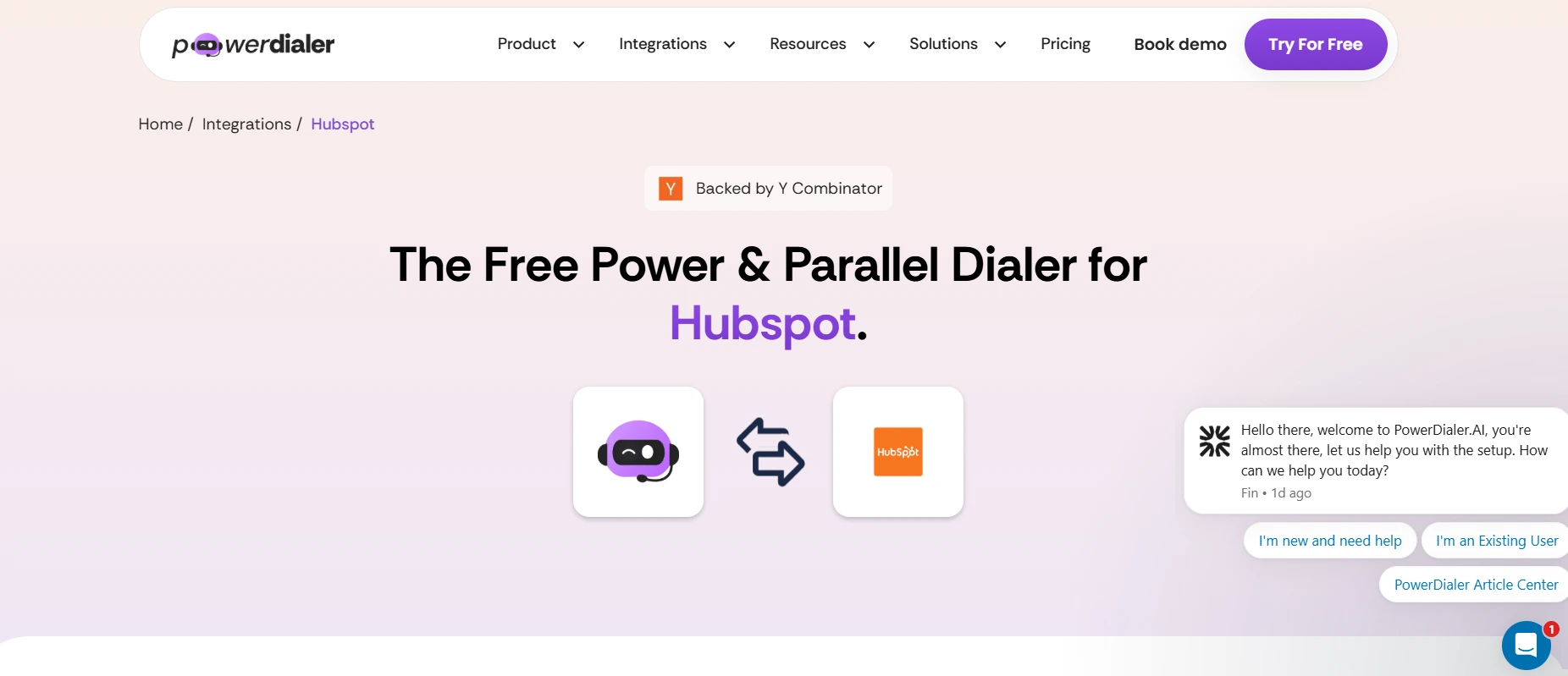
Cold Calling Techniques for Sales Teams: Training Guide
Summary:
Cold calling remains one of the most effective ways for sales teams to generate leads, build relationships, and increase revenue. In this guide, we explored essential cold calling techniques, from researching prospects and crafting strong opening scripts to handling objections, personalizing conversations, and following up effectively. Proper Sales Team Training and the use of the right tools, such as PowerDialer.ai, HubSpot CRM, Aircall, and Five9, can significantly improve efficiency, conversion rates, and team confidence.
We also covered advanced strategies, common mistakes to avoid, and recommended resources, including books, online courses, and software solutions for optimizing outbound sales. By implementing these techniques and leveraging modern tools, your sales team can streamline B2B cold calling, track performance through sales call metrics, and consistently convert more leads into customers. Start applying these strategies today and see measurable improvements in your sales results.

Cold Calling Techniques remain one of the most powerful weapons that can be employed by sales teams to generate leads, build relationships, and grow revenues. Proper Sales Team Training can improve conversion rates, maximize sales prospecting, and allow sales reps to tackle prospects with confidence. Whether your sales team is undertaking B2B Cold Calling or reaching out to B2C consumers, understanding the right strategies and utilizing chief sales resources for cold calling can revolutionize your outbound sales success.
In this article, we’ll explore actionable cold calling tips, proven sales call strategies, and recommended resources to help your team excel in every call.
Even in today's email marketing, social media, and AI campaign-dominant times, cold calling techniques are still a vital component of outbound sales. While the majority of marketers believe that cold calls are old school, studies indicate that sales teams that employ cold calling within their campaign create as much as 30% more high-quality leads than strictly email-based campaigns.
Sales Team Training teaches representatives to prospect, script well, overcome objections, and close. With the proper sales tools in place to support cold calling, this training can make teams more efficient, track their performance using call metrics on sales calls, and alter their process constantly for optimum effectiveness.
Cold calling isn't about grabbing the phone and dialing, it's about planning, preparation, and taking action. Teams that excel at these do it repeatedly over their competition.
Why Cold Calling is Important to Sales Teams

Role of Cold Calling in B2B and B2C Sales
Cold calling remains an integral part of B2B and B2C sales cycles. It helps reps connect with decision-makers in B2B who are not likely to act on email campaigns. In B2C, cold calls provide a touch of human intervention, enabling brands to connect with prospects, respond to questions, and close.
An efficient cold call campaign puts your team in front of the right audience with the right kind of message. Not only does this increase the response rates but also establishes credibility for your business. With the application of scientific cold outreach, sales teams can effectively spot high-worth leads, arrange meetings, and eventually get prospects closer to the end of the sales funnel.
Key Benefits of a Trained Sales Team
Well-trained sales teams enjoy many benefits:
- Higher Conversion Rates: Teams are better able to engage prospects, yielding higher probabilities of closing.
- Greater Confidence: Script and objection-handling information reduces anxiety and enhances professionalism.
- Efficiency: Prepared reps can make more calls with improved results.
- Improved Lead Quality Increased: Preparation enables calls made on prospect interest, maximizing ROI.
- Better Relationship Building: Active listening and customized methods build long-term relationships, not transactional calls.
Technology training enables teams to monitor sales call metrics and where to continue to get better always, which is critical for long-term development.
Crucial Cold Calling Tactics
1. Research Prior to Calling
Research is where good cold calling tactics begin. Knowing your prospect's industry, company issues, and role enables your team to develop tailored messaging.
Actual steps are:
- Scanning LinkedIn profiles for professional background and affiliations.
- Identification of company news, new product release, or recent achievement.
- Identification of pain points and issues pertinent to your solution.
Calls based on research project professionalism and credibility onto the engagement opportunity, instantly creating engagement potential. Research enables reps to tailor their pitch according to prospect business size, industry, and existing solutions.
2. Developing an Effective Opening Script
The call's first few moments are crucial. A good opening script should:
- Get attention immediately.
- State the caller and company clearly.
- State a compelling value proposition.
Excellent starting example
"Hi [Name], I'm [Your Name] from [Company]. We assist [industry] businesses optimize their sales process and drive conversion. Do you have 2 minutes to demonstrate how we can assist your team do the same?"
Scripting advice:
- Make it concise (less than 30 seconds).
- Goal: Discuss benefits, not features.
- Include a question that invites conversation.
3. Handling Objections like a Pro
Objections are inevitable with cold outreach. Proper handling involves:
- Listening Closely: Hear why the objection is raised.
- Acknowledge the Problem: Validate the opportunity's point of view.
- Providing Solutions: Provide case studies, facts, or alternatives.
- Shifting the Conversation: Move the conversation away from hurdles toward advantages.
Some of the typical objections include budget constraints, timing, or being satisfied with an existing supplier. Empowering your team to overcome these confidently is essential to repeat success.
4. Active Listening and Personalization
Active listening allows your team to be cognizant of the prospect's need and adjusts the conversation accordingly.
Techniques include:
- Clarifying difficulties through asking questions.
- Adjusting solutions through prospect's feedback.
- Repeating important points to ensure understanding.
- Personalization increases levels of engagement and rapport, which in most situations is what wins or loses a call.
5. Closing and Follow-Up Tactics
Closing successfully converts conversations into actionable follow-up actions. Best practices include:
Scheduling a demo or consultation.
- Sending follow-up emails with guides, resources, or case studies.
- Utilizing CRM reminders for timely follow-ups.
- Follow-ups are crucial since most sales need several touches to close. Monitoring follow-up success via sales call metrics ensures that no lead is lost.
Training Your Sales Team on Cold Calling
Formal Training Programs
In-depth Sales Team Training consists of:
- Role-Playing Exercises: Rehearsal of real calls to build confidence.
- Shadowing Successful Reps: Learning and observing winning techniques.
- Workshops: Script perfecting, handling objections, and gauging measurements of sales calls.
Training has to be continuous with repeated iterations to reinforce competence and bring in new techniques in harmonization with new trends in the market.
Online Tools and Resources
Technology streamlines training and efficiency of calls:
- CRM Systems: Manage contacts, follow-up interactions, and track outcomes.
- Auto-Dialers and AI Tools: Automate calls, minimize manual work, and increase productivity.
- Call Recording Software: Listen to calls for coaching and enhancement.
Current software enables sales teams to remain well-organized, track results, and continually optimize their cold calling processes.
Metrics to Track Progress
Tracking performance guarantees ongoing improvement:
- Daily or weekly calls.
- Call-to-meeting or call-to-sale ratios.
- Average talk-to-close ratio.
- Follow-up completion rates.
Tracking these metrics exposes strengths, weaknesses, and areas that need extra training.
Recommended Books and Guides for Sales Teams
Books and Guides
- The Ultimate Sales Machine: Provides actionable suggestions on maximizing sales processes and team efficiency.
- Fanatical Prospecting: Concentrates on lead generation techniques and objections handling efficiently.
Online Courses and Webinars
- LinkedIn Learning: Sales training on negotiation, outbound methods, and efficient sales call performance metrics tracking.
- HubSpot Academy: Inbound/outbound sales training, free, on CRM management and follow-up techniques.
Software Tools for Cold Calling
PowerDialer.ai – AI-powered auto-dialer.

PowerDialer.ai is an intelligent auto-dialer designed to streamline outbound sales by automatically dialing prospects and connecting calls directly to sales reps. It integrates seamlessly with most CRMs, ensuring all call data, notes, and follow-ups are logged in real time. The platform provides detailed sales call metrics, allowing managers to monitor call volume, conversion rates, and team performance. AI features help prioritize leads, optimize call schedules, and suggest script improvements for higher engagement. It also supports automated follow-ups, reducing manual work and saving valuable time. By analyzing call outcomes, PowerDialer.ai helps sales teams continuously refine their cold calling techniques.
Drawback: Requires initial setup and training to fully leverage all features.
Pros:
- Automates dialing to save time and increase productivity.
- Integrates seamlessly with most CRM systems.
- Tracks sales call metrics like conversion rates and talk time.
- AI prioritizes high-potential leads and optimizes call schedules.
- Suggests improvements for call scripts to boost engagement.
- Supports automated follow-ups for consistency.
- Provides actionable insights to refine cold calling techniques.
Cons:
- Requires initial setup and some training to fully utilize features.
HubSpot CRM – Tracks calls, manages contacts, and measures engagement.
HubSpot CRM centralizes calls, emails, and prospect interactions, making it easy to manage contacts and track engagement. It integrates with marketing campaigns and email outreach, providing a full view of prospect behavior. Detailed analytics dashboards allow managers to monitor sales call metrics and team performance. Its intuitive interface reduces training time and supports efficient follow-up management. Templates and automation features help maintain consistency across calls and emails. HubSpot CRM improves sales prospecting by organizing leads and tracking outcomes in real time.
Drawback: Free version has limited automation, and advanced features require a paid subscription.
Pros:
- Centralizes calls, emails, and prospect interactions.
- Integrates with marketing campaigns and email outreach.
- Detailed dashboards track sales call metrics and team performance.
- Intuitive interface reduces training time for new reps.
- Templates and automation ensure consistent messaging.
- Organizes leads and tracks progress efficiently.
Cons:
- The free version has limited automation capabilities.
- Advanced features require a paid subscription
Aircall – Cloud telephony sales system.
Aircall is a cloud-based phone system designed for modern sales teams, providing CRM integration, call routing, recording, and analytics. It supports team collaboration with shared numbers and activity tracking, ideal for remote or distributed teams. The platform monitors sales call metrics and provides insights for coaching and performance optimization. Automated workflows and real-time dashboards help teams stay organized and improve lead generation efforts. Aircall is scalable, allowing teams to add users as needed without complex hardware installation. It enhances phone sales training by recording calls for review and feedback.
Drawback: Monthly pricing can be high for small teams or startups.
Pros:
- Cloud-based system with CRM integration for automatic call logging.
- Features call routing, recording, and analytics dashboards.
- Supports team collaboration with shared numbers and activity tracking.
- Scalable for remote or distributed sales teams.
- Enables call review for coaching and improving phone sales training.
Cons:
- Monthly subscription fees can be high for small teams or startups.
Five9 – Enterprise-level call center software.
Five9 is a robust, enterprise-grade call center solution that supports automated dialing, predictive dialing, and AI-assisted lead prioritization. It provides detailed reporting and dashboards for monitoring sales call metrics and team performance in real time. Workflow customization allows call routing and queue management tailored to business needs. AI tools identify high-potential leads and optimize calling schedules for maximum efficiency. The platform integrates with major CRMs to ensure consistent lead data and track conversions. Five9 is ideal for large sales teams needing advanced automation and scalability.
Drawback: Expensive and complex to set up, making it less suitable for small teams.
Pros:
- Supports automated and predictive dialing.
- AI-assisted lead prioritization for high-value prospects.
- Advanced reporting and dashboards to monitor sales call metrics.
- Customizable workflows for call routing and queue management.
- Integrates with major CRMs for consistent lead tracking.
- Scalable solution suitable for large sales teams.
Cons:
- Expensive and complex to set up.
- Better suited for large organizations rather than small teams.
Request a demo today from PowerDialer.ai and streamline your cold calling process and increase conversion rates!
Most Typical Cold Calling Mistakes to Avoid
- No Preparation: Poor prospect research minimizes call effectiveness.
- Too-Much-Dependence on Scripts: Prevent sounding like a robot; make each call personal.
- Failure to Follow-Up: Leads need to be contacted numerous times to close.
- Neglecting Metrics: Without measuring sales call metrics, performance cannot be optimized.
Prevention of these errors keeps your team's cold calling activities productive and results-driven.
Advanced Cold Calling Strategies
- Use Multichannel Outreach: Employ calls with email, LinkedIn, and social media touches.
- Optimize Call Timing: Morning and late afternoon time slots are most likely to get responses.
- Segment Your Prospects: Target the most promising prospects to achieve maximum efficiency.
- Use Data-Driven Insights: Examine outcomes and refine scripts every time.
- Use storytelling: Implement success stories to interest prospects emotionally.
Establish a Call Cadence: Create a structured calling routine for constant follow-ups.
Conclusion
Control over cold call skills is a mix of research, personalization, practice, and proper training. Sales teams adopting systematic Sales Team Training, monitoring the performance of sales call metrics, and employing advanced tools such as PowerDialer.ai can easily enhance B2B cold calling performance.
By concentrating on preparation, engagement, and follow-up, your sales representatives are in a position to convert a higher number of leads into customers and create long-term relationships.
Ready to transform the performance of your sales team?
Implement these cold calling best practices and request a demo of PowerDialer.ai today!
FAQs
Q1: How to train a cold calling sales team?
A: Typically, 2–4 weeks of structured practice, with sporadic follow-up coaching.
Q2: What is the most effective cold calling method?
A: Personalization, active listening, and strong opening script together.
Q3: Is cold calling still effective in 2025?
A: Yes, particularly when coupled with research, technology, and focused outreach.
Q4: What are the tools that enhance cold calling performance?
A: Auto-dialers, CRM software, call tracking, and AI assistants such as PowerDialer.ai.
Q5: How do I overcome cold calling fear of rejection?
A: Role-play practice, value delivery focus, and confidence build-up through training.
